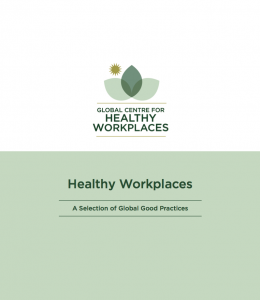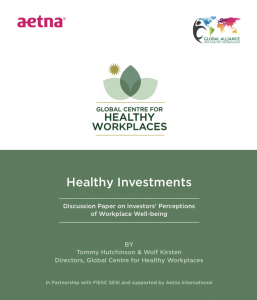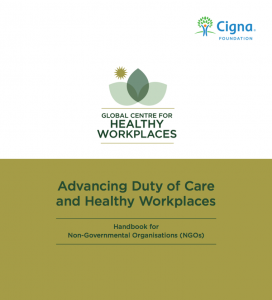Research and Publications
For a full list of our research, publications and case studies (including keynote and Awards Finalists presentations) visit our case studies page: Click here!
Reports and Handbook released at the 5th Global Healthy Workplace Awards & Summit, Singapore 2017

This publication contributes to lively discussion that has transpired across the globe on what constitutes a healthy workplace and how to craft a successful program in order to produce positive outcomes for business and employees.
The publication illustrates how a healthy workplace can be created by showcasing real life strategies and programs from employers in 15 different countries in six continents. All of the case studies are considered good practices as they have been selected from the growing pool of Global Healthy Workplace Awards winners and finalists as well as certified “Healthy Workplaces”.
For a copy of this publication contact: info@globalhealthyworkplace.org
+ Download: Healthy Investments – Discussion Paper on Investors’ Perceptions of Workplace Wellbeing – FIESC SESI / Aetna International
+ Download: Advancing Duty of Care and Healthy Workplaces – Handbook for NGOs – Cigna Foundation
Roundtable Global Alliance for Healthy Workplaces
GCHW co-hosts the Global Alliance Roundtable with FIESC/SESI and consists of representatives of leading international and national organizations in the field of workplace health: WHO, ILO, OECD, World Bank, CDC, ENWHP, World Economic Forum, Eurofound, Ghana Health Service, PanAfrican Business Coalition on HIV/AIDS, Concern Worldwide, Arogyaworld, plus invited guests.
Vision of the Global Alliance for Healthy Workplaces
The Alliance will lead a consultation process among leading stakeholders in order to craft a strategic plan and develop effective actions leading to healthy workplaces and employees worldwide.
It aims to achieve this through:
1. Facilitating information sharing and networking amongst stakeholders;
2. Creating a shared vision;
3. Build a consensus and alignment for joint initiatives
Read the: Washington Statement 2016
Global Survey on Health Promotion and Workplace Wellness
GCHW is working together with Buck Consultants on the Global Survey on Health Promotion and Workplace Wellness. In 2014 a special report was prepared for China and first published at the Global Awards Summit in Shanghai.
2014 Global Findings
While business drivers and health challenges at the workplace are similar across countries, with some variations albeit, programs and communication strategies differ considerably as documented by the 2014 Global Survey on Health Promotion, Workplace Wellness and Productivity Strategies (by Buck Consultants and sponsored by the GHWAwards). The survey respondents identified the following as top objectives driving wellness strategies:
1. Improving workforce morale / engagement
2. Reducing sick leave and disability
3. Improving workplace safety
4. Reducing presenteeism / improving employee productivity
The United States cites reducing health care costs as the main objective due to its unique health care system in which employers feel the direct cost impact of unhealthy employees.
Stress represents the leading health challenge facing employers and employees globally followed by physical activity/exercise and nutrition/healthy eating. This is not surprising as the number of mental illness cases and long-term absentees has increased sharply in recent years in many countries. It is important to point out that workplace safety remains the top challenge in Asia, Latin America and Middle East/Africa.
Potentially one of the most alarming findings from the Global Survey is that only 52 percent of employers worldwide are measuring specific outcomes from their wellness programs. In the U.S., 59 percent of employers say they don’t know if their wellness programs are having an impact on health care cost trend (their top-stated objective). These findings underline the need for more awareness and education around evaluation as well as for systematic planning aligned with a continuous improvement cycle.
Encouraging is the trend of increasing globalization of employers’ wellness programs among multinational companies with 56 percent of the mulitnationals surveyed implementing a global wellness strategy. This has occurred in spite of major challenges due to differing cultures, laws and practices around the world.
Other key findings of the Global Health Promotion Survey include:
• Human Resource (HR) polices related to flexible work arrangements and paid time off ranked as the number one component of wellness programs globally, with Employee Assistance Programs (EAP) ranking number two, driven by their prevalence in the U.S., Canada, Africa and Australia.
• Health risk appraisals (HRA) are a common programming tool with 69 percent offering an HRA today (83 percent in the US).
• Employee wellness communication – with personalization of employee messages – is closely linked to health care cost trend reduction. One hundred percent of the U.S. companies reporting a lower health care cost trend of six or more percentage points send their employees targeted wellness emails. The use of wellness mailings to employees’ homes also is on the rise, recognizing the influence that household members have on each other’s health.
• Posters/flyers remain a widely used communication channel and just as popular as a web portal/intranet.
About the survey
Buck Consultants at Xerox conducted the survey in association with Cigna, Wolf Kirsten International Health Consulting and the Global Centre for Healthy Workplaces. Buck’s sixth global wellness survey analyzed responses from more than 1,000 organizations in 37 countries. Responses are provided by employers who choose to participate and are not a scientifically randomized sample.
The global report is available at www.bucksurveys.com.


